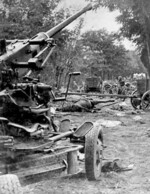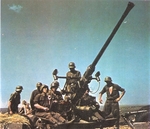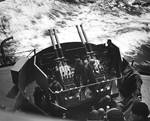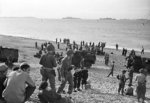![Bofors file photo [5412] Bofors file photo [5412]](/images/weapon_bofors1.jpg)
40 mm Bofors Anti-Aircraft Gun
| Country of Origin | Sweden |
| Type | Anti-Aircraft Gun |
| Caliber | 40.000 mm |
| Weight | 1981.000 kg |
| Ammunition Weight | 0.90 kg |
| Rate of Fire | 120 rounds/min |
| Ceiling | 7.160 km |
| Muzzle Velocity | 881 m/s |
Contributor: C. Peter Chen
ww2dbaseThe design for the Bofors 40-millimeter gun began in 1929. Because the Swedish Navy was small, Bofors A.B. was initially reluctant on picking up the costly research, but obliged after the Swedish Navy agreed to pay for the research costs. Around this time, the German weapon manufacturer Krupp AG purchased a third of the shares of Bofors, leading to the suspicion that the 40-mm gun might be of German design, though there were little evidence to suggest that the development of Bofors and Krupp anti-aircraft weapons were tied together. The prototype unit was completed in Nov 1931, and the design was approved by 1932.Although the project was funded by the Swedish Navy, the first customer of the design was actually the Dutch Navy, who ordered five twin-gun mounts for the cruiser de Ruyter in Aug 1934.
In Apr 1935, Bofors revealed a towage carriage for the 40-mm gun which allowed them to be used by ground forces, therefore expanding their market. In Aug 1935, Belgium made the first order of the land version for a total of eight units. Shortly after, orders came from Poland, Norway, and Finland.
The Swedish Army accepted the weapon into service in 1936, designating them the 40-mm Ivakan m/36 guns.
In 1937, the British Army tested Polish-built version of the Bofors 40-mm anti-aircraft weapon, and eventually accepted them for service under the designation of QF 40-mm Mark I guns; those with flash hiders at the tips of barrels were designated Mk I/2. After acquiring a license to produce them locally, the British made changes to the design so that they could be mass-produced with efficiency. After integrating the Kerrison Director fire control system, the resulting QF 40-mm Mark III "Bofors" anti-aircraft guns quickly became the standard light anti-aircraft weapon of the British Royal Army. They were seen in towed carriages, mounted on trucks, or, in the case of the Crusader III AA Mark I tanks, dedicated armored anti-aircraft vehicles. Self-propelled versions of them served extensively with the British forces from the Normandy beaches in France into the heart of Germany.
The British Royal Navy also made heavy use of the 40-mm "Bofors" guns. Through the Royal Navy, the Americans also received plans for the weapon. Between late 1940 and Jun 1941, the United States produced them illegally to aid British war efforts. In Jun 1941, Bofors A.B. formally granted the United States the license to build them. Both the US Army and US Navy used them during WW2. The US Army designated them the 40-mm Automatic Gun M1.
By the end of WW2, a great quantity of Bofors 40-millimeter guns were built by the United Kingdom, Canada, Australia and the United States; US factories alone built more than 150,000 units. Bofors 40-millimeter guns remain in active service at the time of this writing in 2007, often equipped alongside of modern fire control systems.
Source: Wikipedia. ww2dbase
Last Major Revision: Dec 2007
40 mm Bofors Anti-Aircraft Gun Interactive Map
Photographs
 |  |  |  |
Videos
 |
40 mm Bofors Timeline
| 16 Aug 1940 | US Army Transport American Legion departed Petsamo, Finland for New York, United States with Crown Princess Martha of Norway and her three children on board. Also on board was a 40-millimeter Bofors gun purchased by the US Navy. American Legion was the last neutral ship to be allowed to depart from Petsamo. |
| 28 Aug 1940 | US Army transport American Legion, with destroyers USS Biddle and USS Blakeley in escort, arrived from from Petsamo, Finland to New York City, United States with Norwegian Crown Princess Martha. Also aboard was a 40-millimeter Bofors gun, smuggled in for the US Navy. |
Please consider supporting us on Patreon. Even $1 per month will go a long way! Thank you. Please help us spread the word: Stay updated with WW2DB: |
Visitor Submitted Comments
2.  C. Peter Chen says:
C. Peter Chen says:
24 Sep 2019 10:12:25 AM
To Anonymous of 23 Sep 2019: Thank you for pointing out the missed word. This has been corrected.
24 Sep 2019 10:12:25 AM
To Anonymous of 23 Sep 2019: Thank you for pointing out the missed word. This has been corrected.
3. Anonymous says:
17 May 2025 08:53:51 AM
466th FIELD ARTILLERY BATTALION
Private William Anthony Bernero
17 May 2025 08:53:51 AM
466th FIELD ARTILLERY BATTALION
Private William Anthony Bernero
All visitor submitted comments are opinions of those making the submissions and do not reflect views of WW2DB.
Search WW2DB

News
- » US State Lawmaker John Winter Caught Using Racial Slur "Jap" Before Visiting Internment Camp Site (11 Jun 2025)
- » Köln/Cologne Evacuated After Discovery of WW2 Bombs (4 Jun 2025)
- » US Women's Army Corps "Six Triple Eight" Awarded with Congressional Gold Medal (30 Apr 2025)
- » Race, Holocaust, and African-American WW2 Histories Removed from the US Naval Academy Library (7 Apr 2025)
- » US Government Plans to Purge WW2 Information (17 Mar 2025)
- » See all news
40 mm Bofors Anti-Aircraft Gun Photo Gallery
 |
Current Site Statistics
- » 1,173 biographies
- » 337 events
- » 44,917 timeline entries
- » 1,245 ships
- » 350 aircraft models
- » 207 vehicle models
- » 376 weapon models
- » 123 historical documents
- » 261 facilities
- » 470 book reviews
- » 28,480 photos
- » 365 maps
Famous WW2 Quote
"An appeaser is one who feeds a crocodile, hoping it will eat him last."Winston Churchill
Support Us
Please consider supporting us on Patreon. Even $1 a month will go a long way. Thank you!
Or, please support us by purchasing some WW2DB merchandise at TeeSpring, Thank you!













23 Sep 2019 11:48:16 AM
I would think the US built more than 150 units during WW2. Maybe 150 thousand?